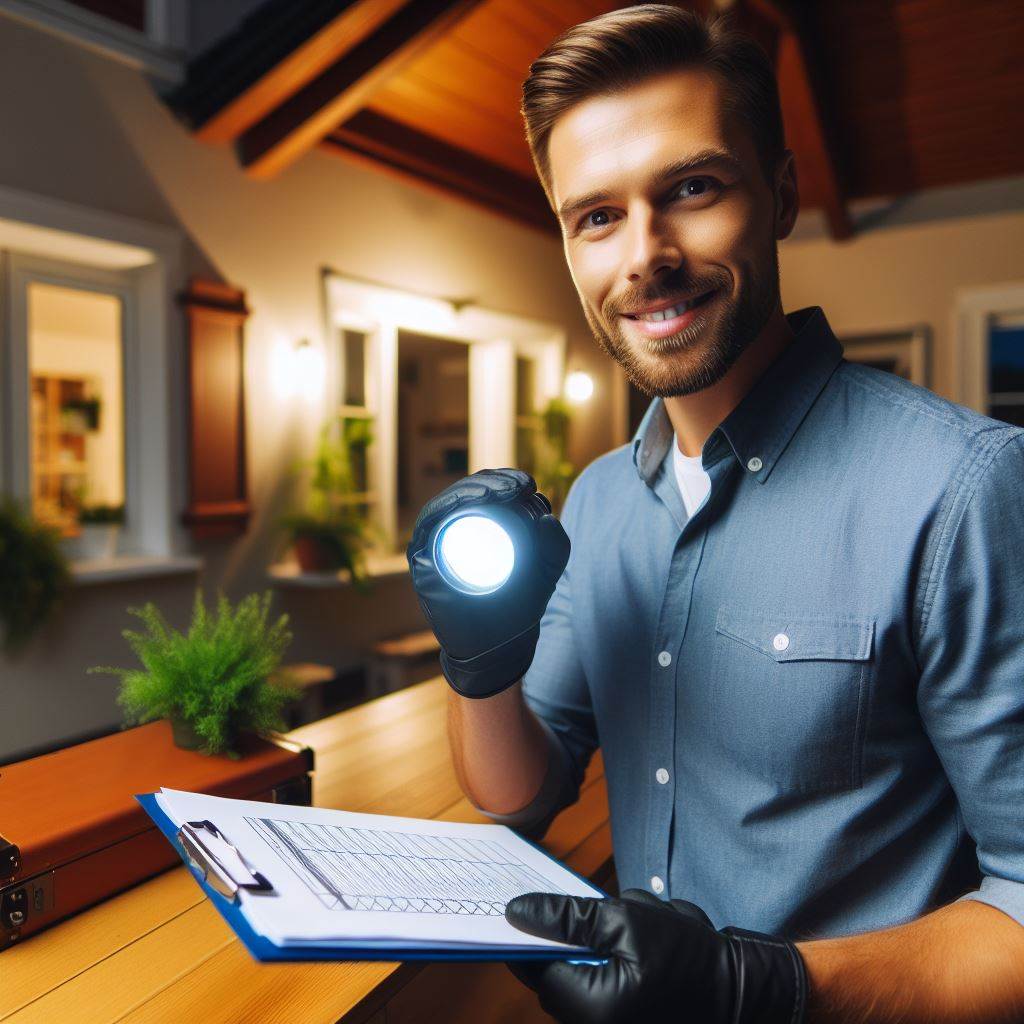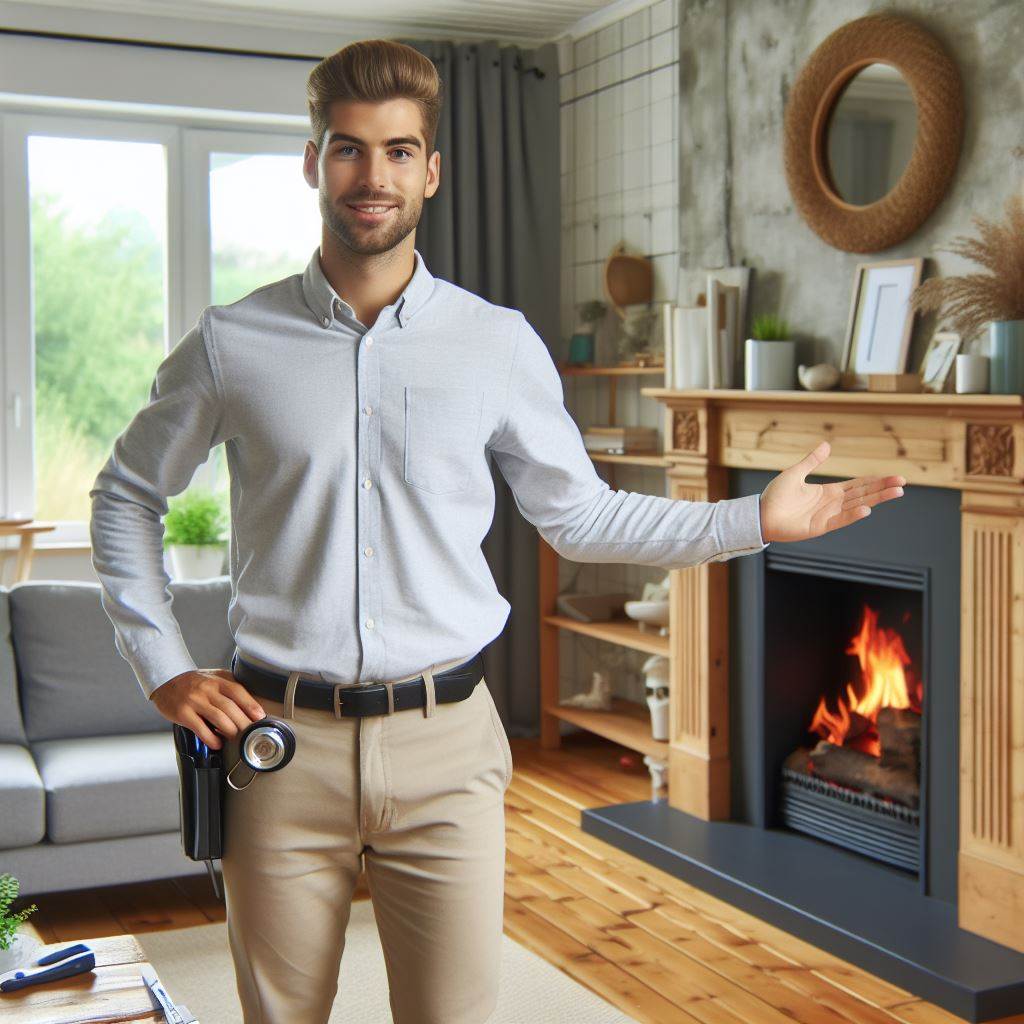Introduction
Buying a home is one of the most significant investments one can make in their lifetime.
However, it’s not a decision to be taken lightly.
Ensuring the property is in good condition is crucial to avoid unexpected expenses and potential hazards down the line.
This is where home inspection plays a vital role. Home inspection is a thorough examination of a property’s condition, typically conducted before purchase.
It provides buyers with valuable insights into the structural integrity, safety, and functionality of the home.
In this blog post, we’ll delve into the crucial checks that should be conducted during a home inspection.
Whether you’re a first-time homebuyer or a seasoned investor, understanding these key aspects can help you make an informed decision and negotiate any necessary repairs or adjustments with the seller.
By being aware of what to look for during a home inspection, you can ensure that your investment is well-protected and that you’re moving into a safe and secure living space.
The structural integrity of a home is paramount.
During the inspection, the inspector will examine the foundation, walls, roof, and overall framing of the house.
Any signs of structural damage, such as cracks in the foundation or sagging rooflines, should be thoroughly investigated.
Faulty electrical systems can pose serious safety hazards.
The inspector will check the electrical wiring, outlets, switches, and circuit breaker panel to ensure they meet safety standards and are in good working condition.
Issues such as outdated wiring or overloaded circuits should be addressed promptly.
A thorough inspection of the plumbing system is essential to prevent leaks, water damage, and mold growth.
Preparing for the Home Inspection
Scheduling a home inspection
One of the first steps in preparing for a home inspection is scheduling it at a convenient time for all parties involved.
This typically occurs after an offer has been made on the property and accepted by the seller.
It’s crucial to book the inspection as soon as possible to allow time for any potential issues to be addressed before closing.
Coordinate with both the seller and the home inspector to find a mutually agreeable date and time.
Communicating with the home inspector
Effective communication with the home inspector is key to ensuring a thorough inspection.
Prior to the appointment, provide any relevant information about the property, such as its age, any recent renovations or repairs, and any specific areas of concern.
During the inspection, feel free to ask questions and request clarification on any findings.
A good home inspector will welcome your participation and provide valuable insights into the condition of the property.
Informing the seller and other stakeholders
It’s essential to keep all parties informed throughout the home inspection process.
This includes the seller, the real estate agents representing both the buyer and the seller, as well as any other stakeholders involved in the transaction.
Be transparent about the inspection schedule and any findings that may arise.
If significant issues are uncovered during the inspection, it may be necessary to negotiate repairs or adjustments to the purchase agreement.
Open and honest communication can help facilitate a smooth and successful transaction for everyone involved.
In short, preparing for a home inspection involves careful planning and communication.
Exterior Checks
During a home inspection, there are crucial checks that need to be conducted, especially when it comes to the exterior of the house.
These checks ensure that the house is in good condition and free from any potential issues.
In this section, we will discuss the important exterior checks that should be performed.
Roof Condition and Inspection
One of the essential checks during a home inspection is assessing the roof condition.
The inspector will examine the roof for any signs of damage, such as missing or broken shingles, leaks, or sagging areas.
They will pay close attention to the flashing around chimneys and vents, as these areas are prone to leaks.
It is crucial to ensure that the roof is in good condition to prevent water damage and costly repairs in the future.
Examination of the Foundation and Structure
Another crucial aspect that needs to be inspected is the foundation and overall structure of the house.
The inspector will look for any cracks or settling in the foundation walls, as it can indicate potential structural issues.
They will also assess the condition of the support beams, columns, and load-bearing walls.
Any signs of damage or instability should be identified and addressed promptly to avoid safety hazards.
Inspection of Windows, Doors, and Exterior Walls
The windows, doors, and exterior walls are not only important for curb appeal but also for energy efficiency and security.
The inspector will examine these areas for any signs of damage, decay, or poor maintenance.
They will check for cracks, gaps, or rotting in the window frames and door frames. Additionally, they will inspect the exterior walls for any cracks, peeling paint, or signs of water intrusion.
It is essential to ensure that these elements are in good condition to maintain a comfortable and secure living environment.
During a home inspection, conducting thorough exterior checks is crucial to identify potential issues and ensure the house’s overall condition.
Assessing the roof, foundation, windows, doors, and exterior walls can help prevent costly repairs and enhance the safety and comfort of the home.
By addressing any problems early on, homeowners can save themselves from future headaches and expenses.
It is recommended to hire a professional home inspector who has the expertise and knowledge to perform these crucial checks effectively.
Remember, a thorough home inspection provides peace of mind and allows homeowners to make informed decisions about their property.
Read: What to Expect in Your Home Inspection
Interior Checks
A home inspection involves thoroughly evaluating the interior of a house, focusing on different key areas to ensure its overall condition and functionality.
The interior assessment includes the following crucial checks:
Evaluating the condition of electrical systems
During a home inspection, it is essential to assess the condition of the electrical systems.
This includes inspecting the wiring, outlets, switches, and the electrical panel.
Any signs of outdated or faulty wiring must be identified.
Additionally, the inspector should check if the electrical system meets the safety standards and regulations.
They should also ensure that the electrical panel is properly labeled, and all breakers are functioning correctly.
Assessing the functionality of plumbing systems
The functionality of the plumbing systems in a house is another crucial aspect to be checked during a home inspection.
The inspector should examine the water supply and drainage systems, including faucets, toilets, showers, and sinks.
They should ensure proper water pressure and check for any leaks or signs of water damage.
The inspection should also involve checking the condition of pipes, including the main water line and sewer line, to identify any potential issues.
Inspection of heating and cooling systems
An important part of a home inspection is evaluating the heating and cooling systems.
The inspector should assess the condition, efficiency, and functionality of the HVAC (Heating, Ventilation, and Air Conditioning) system.
They should inspect the furnace, air conditioning unit, ductwork, and thermostat.
The inspector should also check for proper insulation and ventilation in the house to ensure optimal energy efficiency.
Checking for signs of water damage or mold
During a home inspection, it is crucial to look for any signs of water damage, as well as the presence of mold.
Water stains, discoloration, or peeling paint on walls and ceilings can indicate a water issue.
The inspector should thoroughly examine these areas and also check for any musty odors or visible mold growth.
Identifying water damage or mold early on can help prevent further deterioration and potential health risks to future occupants.
In essence, a comprehensive home inspection involves evaluating various aspects of the interior, including the condition of electrical and plumbing systems, heating and cooling systems, and signs of water damage or mold.
These inspections ensure the safety, functionality, and overall quality of a house, providing valuable information to potential buyers or homeowners.
Read: Key Areas to Check in a Home Inspection

Additional Areas to Inspect
When it comes to home inspections, there are several crucial checks that need to be done.
These checks are essential for ensuring the safety, functionality, and overall condition of a property.
In addition to the basic areas that are typically inspected, there are also some additional areas that should not be overlooked.
Attic and crawl spaces
The attic and crawl spaces are often neglected areas of a home, but they can reveal important information about the property.
During a home inspection, it is important to carefully assess these areas for any signs of damage, pests, insulation problems, or ventilation issues.
Inspecting the attic and crawl spaces can help identify potential problems such as leaks, mold, or pest infestations.
Key things to check in the attic include the condition of the insulation, ventilation, and any signs of water damage or mold growth.
In crawl spaces, it is important to check for any signs of moisture, water leaks, or pest activity. These areas should also be checked for proper insulation and ventilation.
Basement and moisture levels
The basement is another critical area that needs thorough inspection, especially when it comes to moisture levels.
Excessive moisture in the basement can lead to a range of issues such as mold growth, water damage, and structural problems.
During a home inspection, it is crucial to check for any signs of water intrusion, dampness, or leaks in the basement.
There are various methods to assess moisture levels in the basement, including visual inspections, using a moisture meter, or conducting a humidity test.
It is important to check for any signs of water stains, musty odors, or efflorescence on the walls.
Additionally, the home inspector should inspect the basement for proper drainage, sump pump functionality, and the condition of the foundation.
Chimneys and fireplaces
Chimneys and fireplaces are often overlooked during home inspections, but they can present potential safety hazards if not properly maintained.
These areas need to be carefully inspected to ensure they are in good working condition and free from any structural damage or fire risks.
During a home inspection, the chimney should be checked for any cracks or signs of deterioration.
It is also important to inspect the chimney cap, flue, and chimney liner for any damage.
Additionally, the fireplace should be assessed for proper ventilation, any signs of creosote buildup, and the condition of the damper.
In a nutshell, a thorough home inspection should not only cover the basic areas but also include additional areas such as the attic, crawl spaces, basement, chimneys, and fireplaces.
These areas often reveal important information about the condition and safety of the property.
By conducting a comprehensive inspection, potential issues can be identified early on, allowing homeowners to address them before they become major problems.
Read: Credit Score Insights for Potential Homeowners
Checking for Safety Hazards
A thorough home inspection encompasses more than just aesthetics and functionality.
It’s crucial to ensure that the property is safe for its inhabitants.
Here are some key safety checks to prioritize during a home inspection:
Testing Smoke Detectors and Carbon Monoxide Alarms
Smoke detectors and carbon monoxide alarms are essential for early detection of potential hazards.
During the inspection, it’s imperative to test these devices to ensure they are in working order.
This involves pressing the test button on each smoke detector to verify that the alarm sounds loudly and promptly.
Additionally, carbon monoxide alarms should be tested using a carbon monoxide test kit to ensure they can detect this silent, deadly gas.
Ensuring Proper Ventilation Systems
Proper ventilation is crucial for maintaining indoor air quality and preventing issues such as mold growth and respiratory problems.
Inspectors should check ventilation systems in areas such as bathrooms, kitchens, and attics to ensure they are functioning correctly.
This includes assessing exhaust fans for proper operation and checking ventilation ducts for any blockages or damage.
Identifying Potential Electrical Hazards
Electrical hazards pose a significant risk of fire and electrocution. Inspectors should thoroughly assess the electrical system of the home, including outlets, switches, and circuit breakers.
They should look for signs of wear and tear, exposed wiring, and overloaded circuits.
Additionally, inspectors should test ground fault circuit interrupters (GFCIs) to ensure they trip properly and provide adequate protection against electrical shocks.
In a nutshell, safety should be a top priority during a home inspection.
By thoroughly checking smoke detectors and carbon monoxide alarms, ensuring proper ventilation systems, and identifying potential electrical hazards, inspectors can help ensure the safety and well-being of future occupants.
Homebuyers and sellers alike should prioritize these crucial safety checks to create a secure living environment.
Read: Low Credit? Home Buying Strategies for You
Documenting and Reporting Findings
Note-taking during the home inspection
During a home inspection, it is crucial for the inspector to take detailed notes.
These notes will serve as a reference and guide when preparing the inspection report.
The inspector should record any observations, concerns, or findings related to the property.
To ensure accuracy, the inspector should use clear and concise language while jotting down the notes.
It is important to include all relevant details, such as the location and description of any issues or defects found.
This will help in providing a comprehensive report to the client.
Taking photographs and videos for documentation
In addition to note-taking, capturing visual evidence through photographs and videos is an essential part of the documentation process.
A picture can often provide more clarity and understanding compared to written descriptions alone.
The inspector should take high-quality photos and videos of any significant findings.
This includes any areas of concern, defects, or potential problems spotted during the inspection.
These visual records will strengthen the inspection report and allow the client to see the issues firsthand.
When taking photographs or videos, it is important to ensure proper lighting and framing.
Clear and focused images make it easier for the client to understand the problem.
Also, it’s important to include timestamps to document when the visual records were taken.
Preparation of a detailed inspection report
After completing the home inspection and gathering all the necessary information, it is time to prepare a comprehensive inspection report.
This report will include the inspector’s findings, observations, and recommendations.
The report should be well-organized and easy to understand.
It should provide a clear summary of the overall condition of the property, highlighting any major issues or defects.
It is important to separate the findings into different categories, such as structural, electrical, plumbing, or roofing, for easier navigation.
The inspector should include both the positive and negative aspects of the property in the report.
This will provide a balanced and objective assessment.
Recommendations for repairs or further evaluations should be clearly stated, along with any potential safety hazards.
To enhance the report’s credibility, the inspector should reference the notes taken during the inspection and include the photographs and videos documenting the findings.
These visual aids will provide additional context and help the client understand the report better.
Basically, documenting and reporting findings is a crucial part of a home inspection.
Note-taking, capturing photographs and videos, and preparing a detailed inspection report all contribute to providing a comprehensive assessment to the client.
Accuracy, clarity, and organization are key when documenting findings to ensure the client receives a complete understanding of the property’s condition.
Addressing Concerns and Negotiating Repairs
Inspection Findings with Stakeholders
After completing a thorough home inspection, it’s imperative to communicate the findings effectively with all stakeholders involved.
This typically includes the homebuyer, seller, and respective real estate agents.
Transparency is key during this stage to ensure that everyone is well-informed about the condition of the property.
During discussions, it’s important to provide detailed explanations of any issues uncovered during the inspection.
This helps avoid misunderstandings and ensures that all parties are on the same page regarding the necessary repairs or adjustments.
Prioritizing Necessary Repairs
Not all issues uncovered during a home inspection are of equal importance.
Some may be minor cosmetic issues, while others may pose more significant risks or require immediate attention.
It’s crucial to prioritize repairs based on their severity and potential impact on the safety and habitability of the home.
Working closely with a qualified home inspector can help prioritize repairs effectively.
They can provide insights into which issues are urgent and which ones can be addressed over time.
By focusing on the most critical repairs first, homeowners can ensure that their new property remains safe and functional.
Negotiating for Repairs or Pricing Adjustments
Once the inspection findings have been discussed and necessary repairs identified, the next step is negotiation.
In some cases, buyers may request that the seller address certain repairs before finalizing the sale.
Alternatively, buyers may negotiate for a price reduction or credit to cover the cost of repairs they will address themselves.
Negotiating repairs or pricing adjustments can be a delicate process and requires open communication between all parties involved.
It’s essential to approach negotiations with a collaborative mindset, seeking mutually beneficial solutions that satisfy both the buyer and the seller.
Ultimately, the goal of addressing concerns and negotiating repairs during a home inspection is to ensure that the transaction proceeds smoothly and that all parties are satisfied with the outcome.
By fostering clear communication and prioritizing the most critical repairs, homeowners can feel confident in their investment and the condition of their new home.
Conclusion
A comprehensive home inspection is essential to ensure the safety, functionality, and value of a property.
By summarizing the crucial checks during a home inspection, emphasizing the importance of a thorough inspection, and encouraging the use of professional guidance, homeowners can make informed decisions.
In summary, during a home inspection, several crucial checks should be conducted to assess the condition of the property.
These checks include examining the structural integrity, electrical and plumbing systems, HVAC system, roof, and foundation.
Additionally, a thorough inspection should cover issues related to mold, pests, and environmental hazards.
Importantly, a thorough home inspection is vital for both buyers and sellers.
For buyers, it provides peace of mind and allows them to make an informed decision about the property’s purchase.
Sellers can benefit from a pre-listing inspection to identify potential issues and make necessary repairs before putting the house on the market.
While some homeowners may attempt to conduct a home inspection themselves, it is highly recommended to seek professional guidance.
Qualified home inspectors have the knowledge and expertise to identify hidden problems and provide a detailed inspection report. Their insights can save homeowners from costly repairs and future headaches.
In the end, a home inspection is a crucial step in the buying or selling process.
By understanding the essential checks, recognizing the importance of a thorough inspection, and seeking professional guidance, homeowners can ensure a safe and secure living environment.




